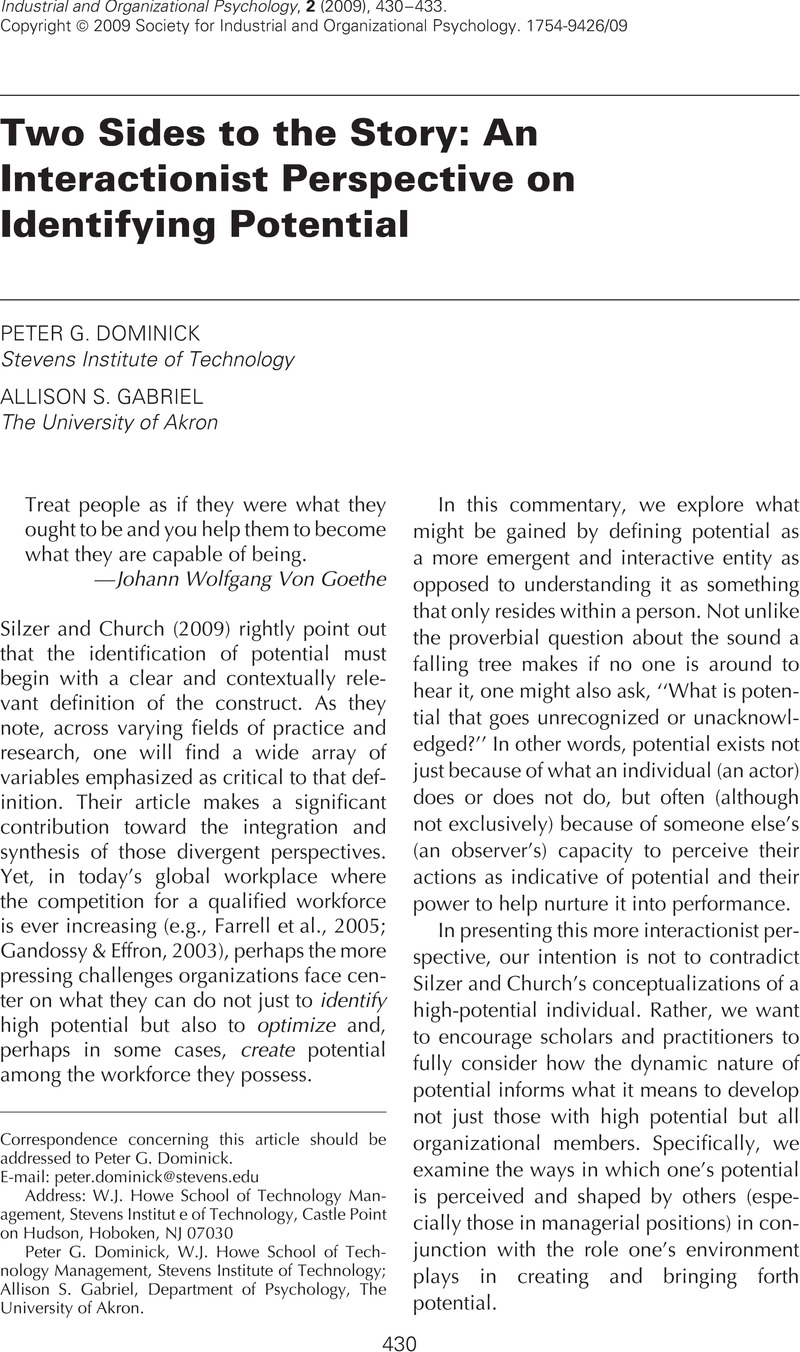Crossref Citations
This article has been cited by the following publications. This list is generated based on data provided by Crossref.
Silzer, Rob
and
Church, Allan H.
2009.
The Potential for Potential.
Industrial and Organizational Psychology,
Vol. 2,
Issue. 4,
p.
446.
Dries, Nicky
2013.
The psychology of talent management: A review and research agenda.
Human Resource Management Review,
Vol. 23,
Issue. 4,
p.
272.
Nijs, Sanne
Gallardo-Gallardo, Eva
Dries, Nicky
and
Sels, Luc
2014.
A multidisciplinary review into the definition, operationalization, and measurement of talent.
Journal of World Business,
Vol. 49,
Issue. 2,
p.
180.
Gallardo-Gallardo, Eva
Nijs, Sanne
Dries, Nicky
and
Gallo, Pedro
2015.
Towards an understanding of talent management as a phenomenon-driven field using bibliometric and content analysis.
Human Resource Management Review,
Vol. 25,
Issue. 3,
p.
264.
Yang, Moonchul
Gyu-Chang Yu
and
Cho,Young-Ho
2017.
Nature of talent: Empirical study of nature versus nurture perspective of talent through individual life-story approach.
The Korean Journal of Human Resource Development Quarterly,
Vol. 19,
Issue. 3,
p.
99.
Golik, Mariela Natacha
Blanco, Maria Rita
and
Czikk, Ricardo
2018.
On the trail of line managers as talent spotters.
Human Resource Development International,
Vol. 21,
Issue. 3,
p.
232.
Lai, Yi-Ling
and
Ishizaka, Alessio
2020.
The application of multi-criteria decision analysis methods into talent identification process: A social psychological perspective.
Journal of Business Research,
Vol. 109,
Issue. ,
p.
637.
Bouland-van Dam, Sophie I. M.
Oostrom, Janneke K.
De Kock, François S.
Schlechter, Anton F.
and
Jansen, Paul G. W.
2021.
Unravelling leadership potential: conceptual and measurement issues.
European Journal of Work and Organizational Psychology,
Vol. 30,
Issue. 2,
p.
206.
Blanco, María Rita
and
Golik, Mariela N.
2021.
Mind the gap: line managers as effective or non‐effective talent spotters.
International Journal of Training and Development,
Vol. 25,
Issue. 1,
p.
23.
Asgari, Elham
Hunt, Richard A.
Lerner, Daniel A.
Townsend, David M.
Hayward, Mathew L. A.
and
Kiefer, Kip
2021.
Red Giants or Black Holes? The Antecedent Conditions and Multilevel Impacts of Star Performers.
Academy of Management Annals,
Vol. 15,
Issue. 1,
p.
223.
Wang, Meng
Xu, Jiuping
Zhao, Shuming
and
Bian, Huimin
2022.
Redefining Chinese talent management in a new context: a talent value theory perspective.
Asia Pacific Journal of Human Resources,
Vol. 60,
Issue. 2,
p.
219.
Golik, Mariela
and
Blanco, Maria Rita
2022.
Homophily: functional bias to the talent identification process?.
Personnel Review,
Vol. 51,
Issue. 2,
p.
620.
Aljbour, Amro
French, Erica
and
Ali, Muhammad
2022.
An evidence-based multilevel framework of talent management: a systematic review.
International Journal of Productivity and Performance Management,
Vol. 71,
Issue. 8,
p.
3348.
Nijs, Sanne
Dries, Nicky
Van Vlasselaer, Véronique
and
Sels, Luc
2022.
Reframing talent identification as a status‐organising process: Examining talent hierarchies through data mining.
Human Resource Management Journal,
Vol. 32,
Issue. 1,
p.
169.
Golik, Mariela
and
Rita Blanco, María
2024.
Talent identification: line managers’ perceptions of their own requirements as talent spotters.
Revista Venezolana de Gerencia,
Vol. 29,
Issue. 105,
p.
196.
Aljbour, Amro
French, Erica
and
Ali, Muhammad
2025.
The Many Faces of Talent Management: Organizational Perspectives on Talent and Talent Management Practices in Jordan.
Human Resource Development Quarterly,



